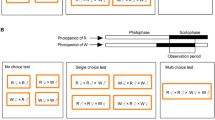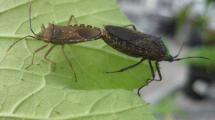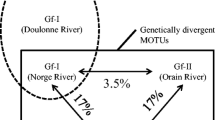Abstract
Spodoptera frugiperda is a Neotropical moth that has diverged into “corn” and “rice” strains. In the US, prezygotic isolation studies have shown that both populations mate assortatively. In addition, recent studies have demonstrated that mating by the same strain individuals is enhanced by an allochronic shift in mating activity and male pheromones are important during courtship. In Colombia, studies on mate choice have never been performed previously, although earlier analyses made in populations from Central Colombia showed no significant differences in time of first mating and copula duration between the strains. Here, we performed multiple choice experiments using a tetrad design composed of individuals of the corn and the rice strains. We found that corn strain females rarely mate with rice strain males, but rice strain females mate with both strains of males. In addition, no temporal isolation was found. A ML (maximum likelihood) approach was used to discriminate between mating propensity and mate choice behaviors in S. frugiperda strains. This approach showed that mating propensity of corn strain males is three times greater than rice strain males. In contrast, in females, the propensity of mating was slightly higher for the corn strain. Finally, the isolation index between the corn and the rice strains from Colombia produced a value of I = 0.33. Our results suggest that prezygotic isolation at the behavioral and temporal levels differ between the US and Colombia. Moreover, in the US temporal isolation appears to have an important role in behavioral isolation but in Colombia temporality is not necessary to reduce encounters between S. frugiperda strains.
Similar content being viewed by others
References
Andersson M (1994) Selection. Princeton University Press, Princeton, p 336
Arévalo-Maldonado H, Zenner de Polanía I (2009) Evaluation of meridic diets for rearing Spodoptera frugiperda (j.e. Smith) (Lepidoptera: Noctuidae) under laboratory conditions. Rev Udcaactual Divulg Cient 12:91–100
Bailey RI, Thomas CD, Butlin RK (2004) Premating barriers to gene exchange and their implications in a mosaic hybrid zone between Chorthippus brunneus and Chorthippus jacobsi. J Evol Biol 17:108–119
Bethenod MT, Thomas Y, Rousset F, Frerot B, Pelozuelo L, Denestier G, Bourget D (2005) Genetic isolation between two sympatric host plant races of the European corn borer. Ostrinia nubilalis Hubner. II: assortative mating a host plant preferences for oviposition. Heredity 94:264–270
Coyne JA, Orr HA (1989a) Two rules of speciation. In: Otte D, Endler JA (eds) Speciation and its consequences. Sinauer, Inc., Sunderland
Coyne JA, Orr HA (1989b) The genetics of postzygotic isolation in the Drosophila virilis group. Genetics 121:527–537
Coyne JA, Orr HA (1997) Patterns of speciation in Drosophila. Revisited Evol 51:295–303
Coyne JA, Orr HA (1998) The evolutionary genetics of speciation. Philos Trans R Soc Lond 353:287–305
Coyne JA, Orr HA (2004) Speciation. Sinauer associated Ins, Sunderland
Coyne JA, Kim SY, Chang AS, Lachaise D, Elwin S (2002) Sexual isolation between two sibling species with overlapping ranges. Drosophila santomea Drosophila yakuba Evol 56:2424–2434
Davies N, Aiello A, Mallet J, Pominankowski A, Silberglied RE (1997) Speciation in two neotropical butterflies: extending Haldane’s rule. P Soc Lond B Bio 264:845–851
Drès M, Mallet J (2002) Host races in plant-feeding insects and their importance sympatric speciation. Philos Trans R Soc B 357:471–492
Gilbert DG, Starmer WT (1985) Statistics of sexual isolation. Evolution 39:1380–1383
Groot AT, Marr M, Schölf G, Lorenz S, Svatos A, Heckel DG (2008) Host strain specific sex pheromone variation in Spodoptera frugiperda. Front Zool 5:20
Groot AT, Marr M, Heckel DG, Schöfl G (2010) The roles and interactions of reproductive isolation mechanisms in fall armyworm (Lepidoptera: Noctuidae host strains. Ecol Entomol 35(S1):105–118
Hammer Ø, Harper DAT, Ryan PD (2001) PAST: paleontological statistics 6 software package for education and data Analysis. Palaeontol Electron 41:9pp
Jiggins CD, Naisbit RE, Coe RL, Mallet J (2001) Reproductive isolation caused by color pattern mimicry. Nature 411:302–305
Johnson JB, Omland KS (2004) Model selection in ecology and evolution. Trends Ecol Evol 19:101–108
Kirkpatrick S, Gelatt CD, Vecchi MP (1983) Optimization by simulated annealing. Science 20:671–680
Levy CH, Garcia-Maruniak A, Maruniak J (2002) Strain identification of Spodoptera frugiperda (Lepidoptera: Noctuidae insects and cell line: PCR-RFLP of cytocrome oxidase c subunit I gene. Fla Entomol 85:186–190
Malausa T, Bethenod MT, Bontemps A, Bourget D, Cournet JM, Ponsard S (2005) Assortative mating in sympatric host races of the European corn borer. Science 308:258–260
Monti L, Genermont J, Malosse C, LalanneCassou B (1997) A genetic analysis of some components of reproductive isolation between two closely related species, Spodoptera latifascia (Walker) and S-descoinsi (Lalanne-Cassou and Silvain) (Lepidoptera:Noctuidae). J Evol Biol 10:121–134
Nagoshi RD, Meagher RL (2003) Fall armyworm FR sequences map to sex chromosomes and their distribution in the world indicate limitations in interstrain mating. Insect Mol Biol 12:453–456
Nagoshi RD, Meagher RL (2004) Behaviour and distribution of the two fall armyworm host strains in Florida. Fla Entomol 87:440–448
Pashley DP (1986) Host-associated genetic differentiation in fall armyworm (Lepidoptera: Noctuidae a sibling species complex? Ann Entomol Soc Am 79:898–904
Pashley DP, Martin JA (1987) Reproductive incompatibility between host strains of the fall armyworm (Lepidoptera: Noctuidae. Ann Entomol Soc Am 80:731–733
Pashley DP, Hammond AM, Hardy TN (1992) Reproductive isolating mechanisms in fall armyworm host strains (Lepidoptera: Noctuidae. Ann Entomol Soc Am 85:400–405
Prowell DP, McMichael M, Silvain JF (2004) Multilocus genetic analysis of host use, introgression and speciation in host strains of fall armyworm (Lepidoptera: Noctuidae). Ann Entomol Soc Am 97:1034–1044
Ríos-Díez JD, Saldamando-Benjumea CI (2011) Susceptibility of Spodoptera frugiperda (Lepidoptera: Noctuidae) strains from Central Colombia to Two insecticides, Methomyl and Lambda-Cyhalothrin: A study of the genetic basis of resistance. J Econ Entomol 104:1698–1705
Ríos-Díez J D, Siegfried B, Saldamando-Benjumea C I (2012) Susceptibility of Spodoptera frugiperda (Lepidoptera: Noctuidae) Strains from Central Colombia to Cry1Ac and Cry1Ab. Southwest. Entomol. In press.
Rolán-Alvarez E, Caballero A (2000) Estimating sexual selection and sexual isolation effects from mating frequencies. Evolution 54:30–36
Saldamando CI, Vélez-Arango AM (2010) Host plant association and genetic differentiation of corn and rice Strains of Spodoptera frugiperda Smith (Lepidoptera: Noctuidae) in Colombia. Neotrop Entomol 39:921–929
Saldamando CI, Tatsuta H, Butlin RK (2005) Hybrids between Chorthippus brunneus and C. jacobsi (Orthoptera: Acrididae) do not show endogenous postzygotic isolation. Biol J Linn Soc 84:195–203
Salinas-Hernández H, Saldamando-Benjumea CI (2011) Haplotype identification within Spodoptera frugiperda (J.E. Smith) (Lepidoptera: Noctuidae) corn and rice strains from Colombia. Neotrop Entomol 40:421–430
Schölf G, Heckel DG, Groot AT (2009) Time-shifted reproductive behaviours amongfall armyworm (Noctuidae: Spodopterafrugiperda host strains: evidence for differing modes of inheritance. J Evol Biol 22:1447–1459
Schölf G, Dill A, Heckel DG, Groot AT (2011) Allochronic separation versus mate choice nonrandom patterns of mating between fall armyworm host strains. Am Nat 177:470–485
Sokal RR, Rolhf FJ (1995) Biometry, Wth edn. H. Freeman and company, New York, pp 725–729
Tregenza T, Pritchard VL, Butlin RK (2000) The origins of premating reproductive isolation: testing hypotheses in the grasshopper Chorthippus parallelus. Evolution 54:1687–1698
Usami T, Yokoyama T, Kubota K, Kawata M (2006) Genital lock-and-key system and premating isolation by mate preference in carabid beetles (Carabus subgenus Ohomopterus). Biol J Linn Soc 87:145–154
Velásquez-Vélez MI, Saldamando-Benjumea C, Ríos- Díez JD (2011) Reproductive isolation between two populations of Spodoptera frugiperda (Lepidoptera, Noctuidae) collected in corn and rice fields from Central Colombia. Ann Entomol Soc Am 104:826–833
Vélez-Arango AM, Arango RE, Villanueva D, Aguilera E, Saldamando CI (2008) Identificación de biotipos de Spodoptera frugiperda (Lepidoptera: Noctuidae mediante marcadores mitocondriales y nucleares. Rev Colomb Entomol 34:145–150
Acknowledgments
We would like to give thanks to Juan Diego Rios- Díez for helping with the insect rearing, to Juan Carlos Salazar for the helpful suggestions in the maximum likelihood approach and to Zenobia Lewis for her useful comments. Financial support to Clara Saldamando was granted by Colciencias (Instituto Colombiano para la Ciencia y la Tecnología), under the grant number: 1118-452-21042 and by Universidad Nacional de Colombia under the grant number: 20101009540. The collection of the larvae and genetic access was provided by the Ministry of the Environment of Colombia, permit number: 4120E1-44703 (24th April 2008).
Author information
Authors and Affiliations
Corresponding author
Rights and permissions
About this article
Cite this article
Saldamando-Benjumea, C.I., Estrada-Piedrahíta, K., Velásquez-Vélez, M.I. et al. Assortative Mating and Lack of Temporality Between Corn and Rice Strains of Spodoptera frugiperda (Lepidoptera, Noctuidae) from Central Colombia. J Insect Behav 27, 555–566 (2014). https://doi.org/10.1007/s10905-014-9451-7
Revised:
Accepted:
Published:
Issue Date:
DOI: https://doi.org/10.1007/s10905-014-9451-7




